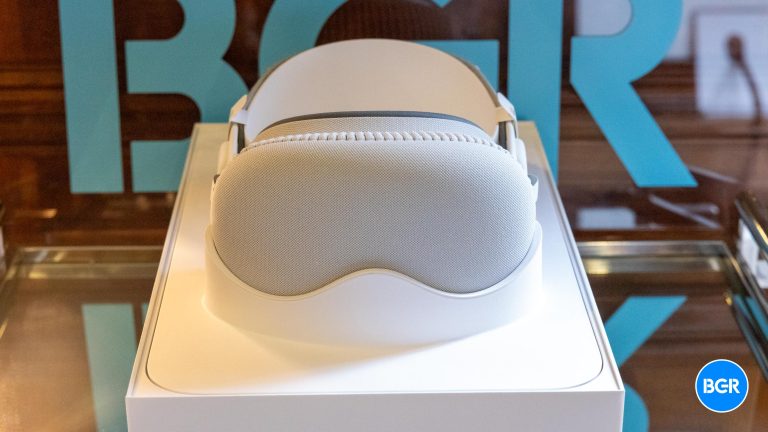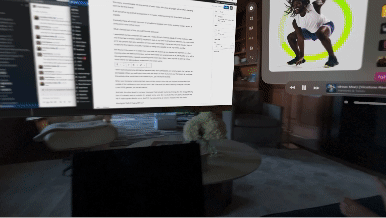Apple Vision Pro
It’s the future of computing. Are you going to participate?
Pros
- Incredible Hardware
- Transformative UI/UX
- Captivating Experiences
- Best Consumption Device
Cons
- First Generation
- Heavy & Uncomfortable
- Buggy
The Apple Vision Pro is heavy. It’s fatiguing to wear. It’s bulky. There’s a fan that turns on and blows warm air over the bridge of your nose. The device can get a bit hot. Yes, you look ridiculous with it on your head. But not a single one of those things matters. At all.
This is the future.
No hyperbole, no bullshit, this is absolutely the future of how we are going to interact with software and technology in our lives, and I kind of hate it because it’s so incredible.
Let’s rewind for a second.

You open the big, towering shell of a box that Apple ships this thing in, and you instantly can see and feel how absolutely impressive this device is before you turn it on.
It has an insanely cool industrial design, in a way that only Apple could pull off. The machined CNC cutouts in the aluminum enclosure are just perfection. Each part of the headset feels like it has a purpose. It has Ready Player One mixed with Loro Piana ski goggles vibes. That means it’s awesome.
From the actual unit to the Light Seal Cushion and Solo Knit band, there is not a more premium device in this class, by far. Apple has leaped ahead of every single VR or AR device on the hardware front by miles and it’s only the company’s first entry. It should be more impressive, but because it’s Apple it feels mostly expected. Crazy, how we’ve been conditioned, huh?

So now you pick it up, hold the left button to turn it on, and holy shit…
You see a blurry passthrough video of your room and decide this isn’t worth the $3,500 and put that thing directly back in its box.
Half kidding here — that blurry passthrough video gets ignored within a couple of seconds because you are instantly presented with the clearest, most detailed iconography you have ever seen using a device like this. What you’re looking at doesn’t seem out of focus, it just looks absolutely crisp and perfect. And we’re just talking about a checkmark icon here that congratulated you for shoving the headset down half a centimeter on your face so it has a perfect fit on your face.
Then it asks you to scan your hands. You hold them out in front of you and quickly see another screen that asks you to look at a dot and select it using a pinching gesture.
You don’t turn your head, you don’t hold your hands up and wave them around, all you do is look at the dot with your eyes and select it with that simple gesture.
The dot is selected. This is brilliant. It’s literally tracking your eyes. Anywhere you look, you can control. And we’re only in the setup app for Christ’s sake.
Apple asks you to now do this to 6 dots around a circle multiple times so it can properly track your eyes to focus on where you’re selecting. It gets brighter and brighter. You made it to heaven.
Now you’re fully in, there’s no turning back. Welcome to the new app home screen. Welcome to the future.

Oh my god, it’s beautiful. The colors, richness, vividness, and depth. They’re right in front of you. It feels like you can reach out and touch them. Wait, you can?!
First thing I open? Dinosaur Encounters. A world where a giant portal stretches out across your entire space, and you’re watching in actual full 3D a dinosaur scene that shows a tiny bit of what this magical device and ecosystem are capable of.
I’m not kidding, within just the first couple minutes you can start to get a sense of how transformational this kind of thing is and can be.
Then you pull up your apps and see how you would actually use something like this. Since Apple Vision Pro scans your surroundings and maps them, you can put these apps and windows in your physical space, and they stay there.
Let’s say you’re in your living room and you want the Apple TV app above your fireplace. Launch the app, pinch and move the window directly where you want it, and place it there. It stays there even if you look away. Even if you walk into another room, when you’re back in the living room, that window is still where you placed it.
It’s mind-blowing. So now you have your movie up, let’s open the Messages app and put it to the side, and then let’s open Safari and put it to the other side so you have a browser open. Just this single use case alone is a transformational way of working with a new computing paradigm. And there’s so much more.
The analog world here gets a digital layer, and you can actually physically interact with it, and it’s so cool.
You tap into a message and a keyboard pops up. You could look at each key and select it using your pinch gesture by pecking one by one, but there is a magical way to type. When you look at the bottom of an app window, there are two selectable options. A dot with an X to close the app, and a bar that you can select to drag and place the apps anywhere.
When you pull the keyboard up closer to you, you can actually take your finger and press it through the digital key, just like it was actual hardware.
And I learned that you can even pull in your app windows instead of having them far away. If you pull them close, you can literally swipe and flick on them directly as if you were using an iPad or iPhone with your finger.

You are manipulating a digital world with your physical self, and it is mind-blowing. That blurry passthrough video I mentioned earlier? It goes unnoticed about 2 seconds into using the headset. You don’t care. The digital world is just too fresh and too clean for you to think about it.
You’re living in the future. You’re taking that Disney+ app, expanding the screen as big as possible, and you’re watching a 3D movie that looks better than any 3D movie you have ever seen on a screen that looks better than a brand new 4K laser projector. And you can be anywhere. On a plane. Or a toilet.
The eye tracking capability and interactions, the gestures, the refinement, and the combination of tiny little beautiful, whimsical, amazing things come together in only a way that Apple can create. You can peek into the future because this honestly feels like some time traveler went 25 years into the future and brought this gadget back with them.
It’s that incredible.
But I’m having a tough time with it, and here’s why.
In Nick Bilton’s feature on it with Tim Cook, he wrote that the Vision Pro made his other devices seem boring and flat when he took it off.
He’s right, but I think it is even worse.
This heavy, uncomfortable for long periods of wear, bulky, ridiculous ski goggle with a battery dangling won’t be like this forever.
It will be half as big and half as expensive in 2-3 years, while becoming two times better and more capable.
Eventually, these will morph into more of a traditional eyeglass form factor, probably contact lenses at some point in the further future.
What’s the bad part of this, you ask? Sounds awesome!
I assembled my first computer at 6 years old. I had a 30-inch Gateway Media PC in my bedroom when I was 8 that had a wireless QWERTY keyboard I kept on my bed. I built and sold websites and music online at 12. My parents had zero restrictions on how much technology I interacted with, and I literally lived on screens. It actually ended up being very valuable to me, my career, and my life.
But this isn’t the same. In 10 years from now when we all pick up our glasses and slip them on in the morning when we head out the door, and we don’t really use smartphones at all, we’re going to be fully in this augmented reality / spatial computing world. And I don’t think I want my kids to grow up in that world. We’re not talking about screen time. It’s screen world.
And what happens when this is the baseline?
I don’t want anyone to be left behind because they don’t participate, and unfortunately, that’s where we are headed. When you walk into a room and see what’s in front of you, but your friends are all looking at this entirely other world that is not visible to you, you will be left behind.
When your company is demoing their new concept product that they just finished a render for in the middle of the conference room, and you don’t see it because you aren’t wearing the Apple Vision Air (Late 2028) glasses, you are left behind.
And look, the other issue is, I’m not sure how good I feel actually having technology like this strapped to my face. It’s already next to my groin, it’s already on my wrist. In your ears.
Do I want all of these CPU/GPU, Bluetooth, and Wi-Fi radio signals directly on my skull? And do I want my eyes staring at screens instead of the real world?
Blue lights? EMFs? Paging RFK Jr.?
I don’t think we have even been asked to make these incredibly tough decisions before to the order of this magnitude, and it feels awful to honestly consider them.
It’s awful because this is the most incredible piece of technology, maybe the most incredible product I have ever tried. But I keep trying to put some distance between it and myself. I haven’t worn it all day yet, I haven’t fully worked in it, though I do find myself missing the experience when I’m not wearing it. It is fatiguing, it’s more focused on consumption than productivity, but this is the V1.
Some of these things will and obviously can be fixed and improved, but the overall point still stands.
The future is not coming. It’s here. And you will have to decide if you’re going to participate in the AI-generated Spacial Computing future where digital replicas of ourselves become the main way that people see, hear, touch, connect, and experience moments together. In addition to a whole lot more.
Ideally there would be some balance in this new world, one in which we didn’t need to be fully immersed in a digital life 24/7. Where our kids actually played sports with their friends, maybe even had the courage to talk to people on the phone instead of text, or god forbid, date someone, drink a sip of alcohol, or do anything fun with their lives.
Ah, the good old days.
But for this minute, I’m going outside to touch some grass without my phone, watch, headset, or AirPods, and it would be really nice if the world did the same.










